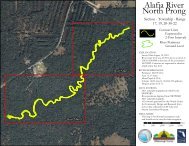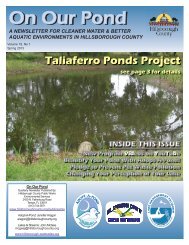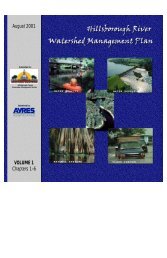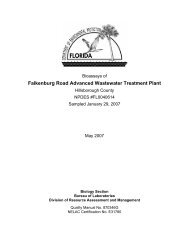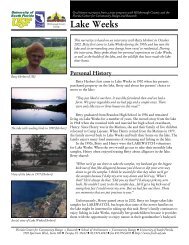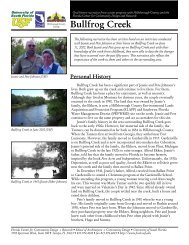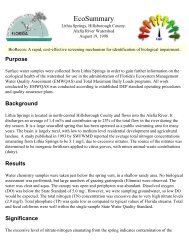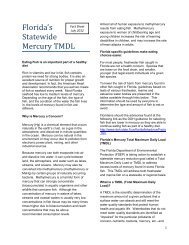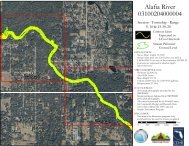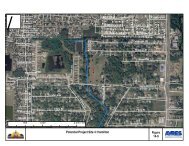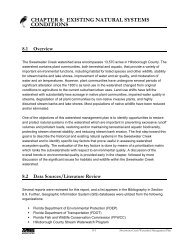Rocky Brushy Creek Watershed Mgmt. Plan (2007) -- Part 2
Rocky Brushy Creek Watershed Mgmt. Plan (2007) -- Part 2
Rocky Brushy Creek Watershed Mgmt. Plan (2007) -- Part 2
You also want an ePaper? Increase the reach of your titles
YUMPU automatically turns print PDFs into web optimized ePapers that Google loves.
EXISTING NATURAL SYSTEMS CONDITIONSCypress swamp (621)Cypress swamp is the most common wetlandcommunity in the watershed. Formerly (1950)occupying 10.3% of the land in the <strong>Rocky</strong> <strong>Creek</strong> -<strong>Brushy</strong> <strong>Creek</strong> watershed, the cypress swampcommunity currently (2004) covers 8.8% of thewatershed. It is associated with several soils,including: Myakka fine sand, Basinger, Holopaw,Samsula depressional soils, that are located onthe margins of most of the 38 lakes in thewatershed. These natural systems are typicallylarge basins characterized by peat substrates,seasonal to year-round inundation, still water, andoccasional fire. They may be associated with the channel of the <strong>Creek</strong> or isolated during the dryseason. The typical vegetation canopy species is pond cypress which is associated with swampblack gum, southern red maple, laurel oak, and dahoon holly. The understory is shrubby and iscomposed of fetterbush, Virginia willow, and buttonbush. The herbaceous understory includes avariety of ferns (royal fern, cinnamon fern, netted chain fern, Virginia chain fern, and toothed midsorusfern) associated with alligator flag, water hoarhound, false nettle. Endangered andthreatened species such as butterfly orchid, Spanish moss, and ball moss occur occasionally incypress swamps.Bay Swamp (611)Not recognized in the 1950 mapping, the bay swamp community currently (2004) covers 0.2% ofthe watershed. Canopy trees include lobllolly bay, sweetbay, swamp bay, slash pine, and loblollypine. Understory vegetation is typically dense and composed of gallberry, fetterbush, wax myrtle,and titi.Stream and Lake swamp (615)Formerly (1950) occupying 3.6% of the land in the <strong>Rocky</strong><strong>Creek</strong> - <strong>Brushy</strong> <strong>Creek</strong> watershed, the stream and lakeswamp community currently (2004) covers 2.03% of thewatershed. The community is also referred to asbottomland hardwood forests and is associated with thestream channel. Canopy tree species include red maple,water oak, sweetgum, swamp black gum, pond cypress,and some tall Carolina willows. The subcanopy andunderstory in this community are typically of open aspectexcept in forests where the hydroperiod (depth and duration of inundation) has been reduced,which has allowed a tangle of shrub species to become established on the forest floor invade andclose the understory. In such cases, shrubs such as fetterbush and buttonbush make the forestvirtually impenetrable.8-10<strong>Rocky</strong>/<strong>Brushy</strong> <strong>Creek</strong> <strong>Watershed</strong> Management <strong>Plan</strong>



